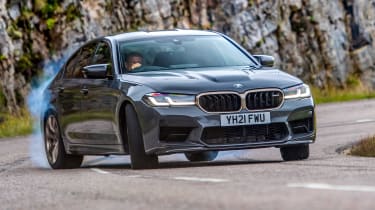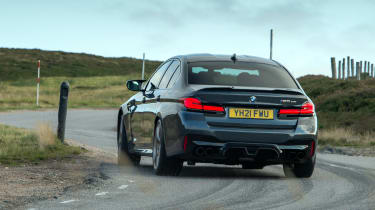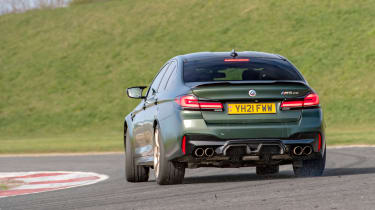BMW M5 CS (F90, 2021 - 2023) review – nonsensical on paper, sublime in practice
Never has a modern supersaloon been more tactile or engaging; the M5 CS is truly an all-time great
While a lightweight BMW M5 seems an odd proposition, it's proven to be a formula we never knew we needed. Admittedly at 1825kg the M5 CS isn’t a lightweight in the truest sense, rather it’s 70kg lighter than an M5 Competition and anything up to 150kg lighter than a few rival twin-turbocharged, V8 engined, four-wheel-drive executive hot rods like the Audi RS7 or Mercedes-AMG E63 S.
But before we go into specifics, it's worth noting that the M5 CS follows a pathway lead by the M2 CS as proof that BMW M is on some serious form. It might be a generation behind the latest M3 and M4 in design (some might say mercifully so) but the CS was not only good enough to be included in our evo Car of the Year competition, it took the overall title. Yes folks, the BMW M5 CS was our 2021 car of the year. Here's why.
It's impossible to argue that 1825kg is not a chunky mass to haul around even when the most powerful BMW M engine is at your disposal. Yet the M5 CS not only feels a more potent car than the M5 Competition on which it is based, but a more resolved and therefore engaging supersaloon as a result. The shades of grey that are often hard to define in an M5 Comp are much clearer here, providing a more vibrant and colourful connection between you, the car and the road.
More reviews
The 10bhp increase is neither here nor there for an engine that already produces 616bhp, but the resulting 626bhp makes the M5 CS the most powerful M5 ever, and even with the accompanying 553lb ft unchanged from the M5 Comp, getting down a road quickly isn’t an issue – it shaves three-tenths from the M5 Comp’s 0-62mph time, reducing it to 3sec dead before it tops out at 189mph. But the CS can’t be defined by its numbers. There’s so much more to it than that.
There’s more urgency to the 4.4-litre V8. It revs quicker, there’s a sharper edge to its throttle response when you wind up through the driving modes and you can be more precise when dialing in the required levels of forward momentum. The effortless performance of the M5 Competition feels softer and languid in comparison, jump in an Audi RS6 or RS7 after a stint in the CS and you’d be convinced the Audi’s throttle pedal has been restricted. The CS has the feral, thoroughbred reactions to match Porsche and AMG’s V8s when in their hottest forms.
The automatic gearbox means the shifts don’t come as quickly or with the clarity of the best double-clutch boxes and it’s noticeable on complex roads when slowing for tighter corners when the immediacy of the downshift you’re expecting isn’t quite there. Upshifts are less of an issue, any delay is negligible, but with the configurable M buttons and the ability to still change the gearbox shift speeds you can experiment away until you find your preferred ratio swapping rate, although being able to select different up and downshifts speeds would provide a further geek out layer of interaction.
It’s the layers beneath the CS that really transform this M5 though. A drop in ride height and the adaptive dampers from the M8 Gran Coupe combined with a thorough overhaul of the car’s chassis geometry and bushes result in an M5 with a level of dynamic ability wholly unexpected. And it’s thoroughly welcomed.
On an evo test route that would unsettle the rear axle of an M5 Comp to the point of distraction there’s a calmness and control to the M5 CS’s chassis that brings with it a new found level of agility and precision. Where you would normally approach corners in a car of this size and bulk with a slow entry speed, a period of waiting for it to settle before calling upon all of the performance on offer to fire you out of the apex, in the CS it’s beautifully different.
It’s so much more responsive to your inputs via the Alcantara steering wheel that you dive through the turn-in and arrive pin sharp on the apex already driving for the exit in one clean, fluid motion. Your confidence in the car increases with each challenge you face, the ability of the CS never waning, your admiration for it always increasing.
Then there is the ride quality. Not only is it more relaxed when you want it to be at low speeds – highlighting how firm an M5 Comp is even in Comfort mode – but there is a sizable improvement in body control, and the link between the front and rear axle to the road. No longer does the rear of the car hop, skip and jump when it comes into contact with a poor surface when under power, instead it retains a cast iron grip keeping the tyres (our test car came equipped with the excellent Michelin Pilot Sport 4S instead of the bespoke Pirelli P Zero Corsa) firmly in contact with the road at all times. It means you’re more relaxed when sitting in the M3’s carbon seats, gripping that Alcantara wheel and pulling/pushing the tactile shift paddles.
This means there’s more grip to lean on and work with. Switch every mode off and turn the CS into a 626bhp rear-drive saloon and it will slide around until your heart is thumping out of your chest, but adjust the drivetrain to four-wheel drive Sport and select MDM and the blend of grip and slip feels just right for the road, providing enough movement to maintain momentum without the need for you to be constantly reigning it in.
The M5 CS feels slightly less at home on a track. Its still wickedly fast and indulgent, but the 1825kg kerb weight comes to the fore and dictates much of how you extract a lap time. It's all about managing the forces through the tyres and keeping them within their peak window of grip; they wilt under all that weight and power if you hustle the car, so the CS requires a certain level of restraint.
Concentrate on feeding it smooth, accurate inputs, and the M5 responds far better. You can use the transparent feedback through the wheel and chassis to hone in on the limit, gently loading the tyres and reaching a wonderful balance point where the car takes on a few degrees of slip while clawing forwards. The xDrive system is ruthlessly effective, but it always leaves margin for the driver to make the difference.
Even on a fast, open circuit the CS feels indomitable and monstrously fast, and the speed at which you arrive at braking zones is a touch intimidating. Thankfully, the standard fit carbon-ceramic brakes (which save 23kg on their own) are powerful and resilient on circuit, with a progressive pedal action to help trail the car right into the apex. Such is the level of confidence the chassis inspires, your braking inputs are less aggressive and shorter than they would be in an M5 Comp.
Prices and rivals
The £38,000 premium the CS commands over an M5 Competition is far from an insignificant sum of money. Yes it includes the engine’s performance increase and the work to the chassis (this alone is worth half the cost in its own right) and a whole lot more bespoke elements, from the gold/bronze wheels and yellow daytime running lights.
There is also a carbon fibre bonnet that features an M5 CS logo embossed in its underside and the interior is a homage to bucket seats (there are four of them) and Alcantara, and the deletion of a luxury such as the centre armrest/storage box between the front seats. And there’s an outline of the Nürburgring integrated into the perforations in the headrests.
But the one thing you can’t attribute a cost to is how it drives. Quite simply the M5 CS is a bewitching, enthralling and captivating supersaloon. One of the very best there has been, and you can’t put a price on that.
Specs
| Engine | V8, 4395cc, twin-turbo |
| Power | 626bhp @ 6000rpm |
| Torque | 553lb ft @ 1800-5950rpm |
| Weight | 1825kg (349bhp/ton) |
| 0-62mph | 3.0sec |
| Top speed | 189mph (limited) |
| Price | £140,780 |




